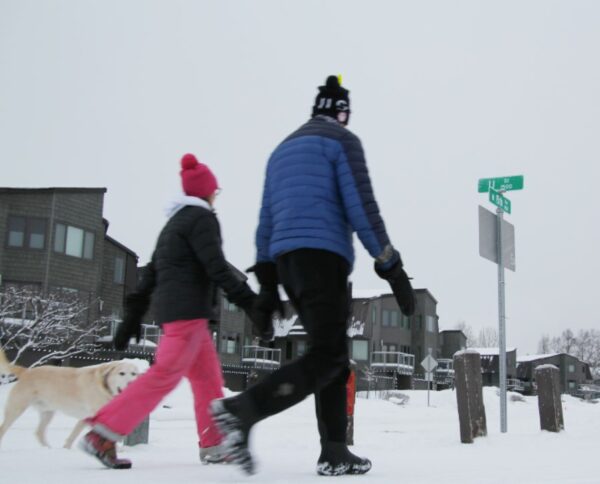
Sandra Syrup lives with her husband in a ranch-style home in Anchorage’s Hillside neighborhood. Beside her house is a garage and a carport, which she’s planning to turn into a separate apartment by next year.
After a year of planning, she finally found an architect and contractor up for the job.
“My mother who lives in Texas — she has neuropathy in her feet, and she needs a good environment to come to in the summertime. So she’ll be utilizing it for about four months out of the year,” said Syrup.
Keeping elders in the state is just one of the advantages touted by proponents of accessory dwelling units, also called ADUs. The idea is that ADUs add more housing on the same amount of property by creating living spaces in backyard cottages or by adding apartments — whether by adding them onto houses or by converting garages, like Syrup plans to do.
Just 2% of single-family homes in the city have ADUs, according to an analysis by the thinktank Sightline, which advocates for sustainable communities in the Pacific Northwest. Advocates say incentivizing ADUs could be an easy way to boost housing options in Anchorage, where a housing shortage has been a persistent roadblock to progress on fighting homelessness.
“Each housing unit, we need,” said Midtown Assembly member Meg Zaletel “We absolutely need it.”
But questions remain about how to best drive up the percentage of Anchorage homes with ADUs, and how far the city will go.
Mayor Dave Bronson’s administration recently proposed pausing property taxes for 10 years on new ADUs, but some advocates say that won’t be enough. They’re pushing for the city to also ease complicated regulations on ADUs and even to consider paying homebuilders to help offset the construction costs.
“The tax abatement piece is one small piece, but there still needs to be more in terms of code changes,” said Jeanette Lee, a researcher with Sightline. “One big impediment to building ADUs is parking requirements.”
Under city code, owners are required to get an exemption for on-street parking for new ADUs or add parking spaces in a garage, which could add tens of thousands of dollars of construction costs.
Another requirement Lee thinks should be axed: requiring property owners to live in one of the units. She said that lowers desirability for investment in ADUs by owners.
Lee said it’s based on stigma about renters.
“The idea is that people who are actually living on a property are going to be more responsible than our neighbors,” she said. “That’s something that’s not really backed up by data.”
Hans Rodvik, a spokesperson for the Bronson administration, said the mayor is open to regulation changes. The Assembly is taking public comment on revisions to its land use code at its meeting Tuesday evening. Rodvik said the mayor is working on revisions to incentivize ADUs.
“The combination of tax abatement and code revisions are both needed to incentivize the construction of more ADUs within the MOA,” he wrote in an email.
The Anchorage Assembly eased many restrictions on ADUs in 2019, expanding neighborhoods where they can be built and allowing more people can live in them. The changes had a modest impact on the number of ADUs built, Lee said, but the effects of the pandemic clouded trends.
She said other cities, like Seattle, saw new ADU construction more than double after reforming regulations.
Still, Lee acknowledged, the biggest hurdle for would-be ADU builders is often cost, not regulations.
ADUs in newly built structures in Anchorage cost an average of roughly $79,000, according to Sightline. Some say tax abatement could change the calculus for homebuyers without costing the city money upfront.
“Ten years with no property taxes on that piece is kind of a big deal,” said Questa Locke, a realtor in Anchorage.
Locke said she gets inquiries about once a week from buyers thinking about building an ADU, but many are deterred by costs for permitting and construction.
Zaletel said while she supports the tax incentive in principle, she thinks it could be improved to encourage people to use their ADUs as permanent housing, instead of as nightly vacation rentals, like AirBnBs.
There were nearly 1,200 units listed on nightly vacation rental websites in Anchorage at the end of 2021, according to AirDNA, a company that collects data about vacation rentals. There are more than 1,000 ADUs in the city, though about 400 aren’t registered, according to Sightline.
Zaletel said her substitute ordinance would specify that the tax pause only applies to homeowners who are using the ADU for long-term housing instead of nightly rentals. And it would apply the abatement to homeowners who have unregistered ADUs who bring them into compliance with regulations.
“If this is going to incentivize people building units, or changing the use of their units, then I think it’s a net positive,” said Zaletel.
While tax abatement will help that, it’s also something that’s hard for property buyers to calculate, said Andre Spinelli with the home building company Spinell homes.
“Most people don’t really think about that stuff,” he said, “It’s all wrapped up in their mortgage.”
Spinelli said for him, direct grants to home builders to build ADUs might do the trick. In 2017, Juneau offered $6,000 grants to construct ADUs. Twelve were built.
So far, Anchorage Assembly members and the mayor haven’t shown an appetite for upfront payments, which the city would have to pay for out of pocket.
Still, Spinelli said, he’s not against the tax abatement, though he’s curious to see how much construction it would really spur.
“I just don’t think, you know, they’re just gonna be like, all of a sudden, a bunch of people are gonna be like, ‘Oh, well, now that this thing’s out there, I got to build a new house,’” he said.
[Sign up for Alaska Public Media’s daily newsletter to get our top stories delivered to your inbox.]
Lex Treinen is covering the state Legislature for Alaska Public Media. Reach him at ltreinen@gmail.com.





